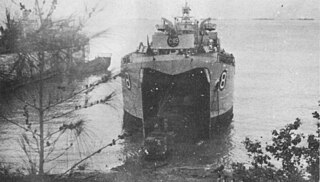1943 convoy duty
She was first assigned to the Europe-Africa-Middle East Theater. Departing Little Creek, Virginia, on 27 July 1943, LST-17 headed for Oran, Algeria, arriving there on 14 August 1943. She sailed with Convoy KMS 23 during part of its journey from Gibraltar, to Port Said, Egypt, sailing from Oran, to Bizerta, Tunisia.LST-17 sailed from Algiers, Algeria, to Port Said, Egypt, in October 1943, this time joining with Convoy UGS 19. On 3 November, she set out with nine other LSTs from Aden, Yemen, for Bombay, India, arriving on 10 November. She left the next day for Colombo, British Ceylon, arriving on 16 November. At the end of December she left Calcutta, with 11 LSTs headed for Colombo, British Ceylon, arriving 27 December 1943.
1944 convoy duty/Normandy invasion
LST-17 joined Convoy MKS 38 at Bizerta, in January 1944, as it was en route to Gibraltar, arriving 1 February. Forming Convoy MKS 38G she rendezvoused with Convoy SL 147 and sailed for Liverpool on 2 February, arriving on 13 February 1944.
LST-17 arrived at Milford Haven, Wales, on 3 March 1944. Leaving Milford Haven on 3 March 1944, she proceeded to Portland and returned to Milford Haven on 15 March 1944. On 31 March, she left for Lough Foyle and then visited in turn Derry, Roseneath (sic), Plymouth, Senny Cliff Bay, Weymouth, Solent and Southampton, returning to Solent, on 28 May 1944, to prepare for the Normandy invasion, towing Rhino barges on which were railway equipment for use in France.
She sailed to the sea off Normandy, detaching the Rhino barges to the beach at 16:15 on 6 June 1944. At 20:10 she received the first group of casualties via DUKWs and returned to Solent, on 7 June. She left Solent, for her second trip to France, on 9 June, anchoring two miles (3.2 km) off the Normandy beach at 03:35 on 10 June, moving pontoons ashore and returned to Solent, 11 June, proceeding to Southampton, the next day. On 15 June, she left Southampton and anchored off France. The following day she beached at "JIG GREEN" on the "Gold" assault areas at 11:08 with British and Canadian troops. She left the beach on 17 June, and returned to Tilbury, England, proceeding to Solent, on 20 June. She left Solent on 23 June 1944, and beached at Normandy, France, at 16:39 that day, returning to Solent, on 24 June. Again on 27 June, she left Solent and beached in Normandy, France, at 18:48, leaving Normandy, on 28 June, and arriving at Tilbury, on 29 June. She departed Southend on 30 June, arriving at Seine Bay, France, on 1 July 1944, with Convoy ETM 22.
LST-17 sailed for London, on 4 July. Her next trip was on 14 July 1944, when she left Thames Dry Dock and arrived at Normandy, on the same day, returning to Southampton on 16 July. Again on 18 July, she left Southampton, this time for Utah Beach, Normandy, France, leaving there on 19 July, and arriving at Weymouth, England on 20 July. She left Weymouth on 21 July, and arrived at Omaha Beach that same day and returned to Portland. From this time until September 1944, she made continuous trips between Utah Beach and England. Arriving at Cornwall, on 17 September 1944, she departed for Norfolk, Virginia, on 5 October 1944, and taking on fuel and provisions at Norfolk, on 24 October, she arrived at Boston, on 26 October 1944, for overhaul.
On 10 November 1944, her Coast Guard crew was "relieved of manning" LST-17.










